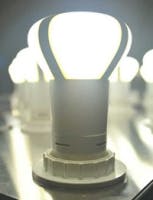DOE launched the L Prize initiative to spur development of high-quality, high-efficiency LED replacements for the common light bulb.
The Philips submission will now undergo comprehensive evaluation, including performance testing conducted by independent laboratories, field assessments conducted with utilities and other partners, long-term lumen maintenance testing and stress testing under extreme conditions. Consumer pricing and retail availability have yet to be determined.
Meanwhile, the DOE said that it hopes to see more entries from both large and small manufacturers. Entries will be accepted in each product category until a winner is declared. The first entrant in each category to successfully meet the competition requirements will receive a substantial cash prize as well as L Prize partner promotions and incentives.
“Philips is confident that the product submitted meets or exceeds all of the criteria for the L Prize,” said Rudy Provoost, CEO of Philips Lighting. “By being the first to enter this very tough competition, Philips has demonstrated its commitment once again to playing a leading global role in lighting innovation and energy conservation.”
Established through the Energy Independence and Security Act of 2007, the L Prize offers substantial rewards for the first manufacturer to meet its very demanding requirements – ensuring that performance, quality, lifetime, cost and availability meet expectations for widespread adoption and mass manufacturing.
In addition to the significant cash prize, the first manufacturer to fully meet the competition’s requirements will also be in consideration for federal purchasing agreements, utility programs and other incentives. DOE says that, to date, 27 utilities and energy efficiency program partners stand ready to promote and develop markets for the winning products.
Required metrics for the 60-Watt incandescent LED replacement, as laid out by DOE, include:
- Efficacy of more than 90 lm/W, which exceeds the efficiency of all incandescent and most compact fluorescent sources today
- Energy consumption of less than 10 watts (compared to a 60 watt incandescent)
- Output of more than 900 lumens, equivalent to a 60 Watt incandescent light bulb
- Lifetime of more than 25,000 hours, which is 25X greater than a typical incandescent bulb
- Color Rendering Index (CRI) greater than 90
- Color Temperature between 2700K and 3000K i.e. “warm” white light comparable to that of incandescent sources
Every year it is estimated that more than 425 million 60-Watt incandescent light bulbs are sold in the United States alone, representing approximately 50% of the domestic incandescent light bulb market. According to DOE, an LED replacement for this could save 34 terawatt-hours of electricity in one year, enough to power the lights of 17.4 million U.S. households. It would also avoid 5.6 million metric tons of carbon emissions annually.






